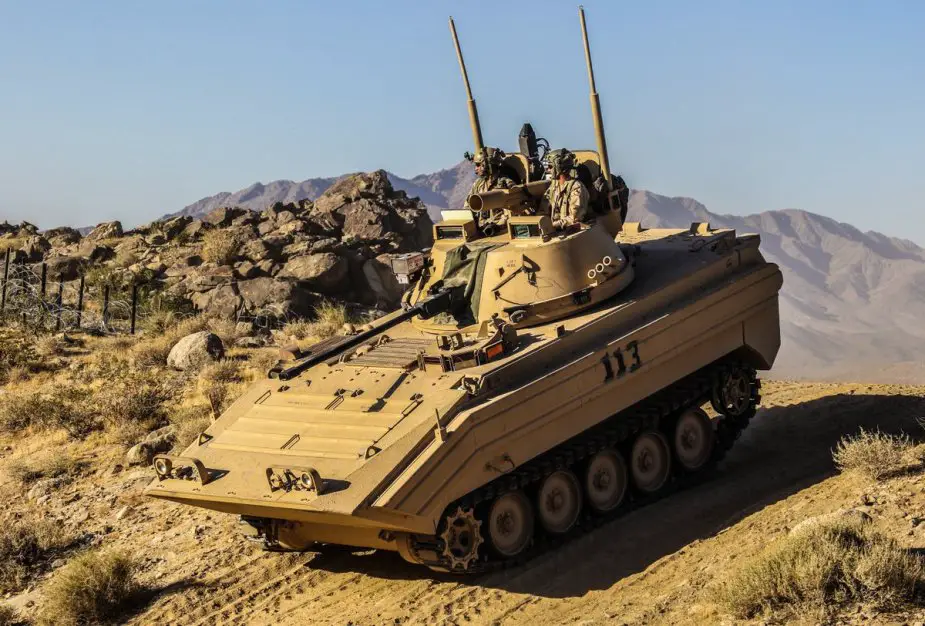US Army plans to modernize its OPFOR (Opposition Force) program
While the United States fought conflicts and insurgencies in the Middle East, South Asia, and Africa over the last seventeen years, potential adversaries were studying U.S. operations and developing sophisticated weapons, munitions, and disruptive technologies. U.S. forces must anticipate that adversaries will employ these increasingly advanced systems, some approaching or even surpassing U.S. capabilities, while also proliferating them to their allies and proxies around the globe. Mario J. Hoffmann explains on Army.mil.

M113 modified to look like a Russian ICV (Picture source: Twitter)
Both Russia and China, our two most sophisticated strategic competitors, are developing new approaches to conflict by modernizing their concepts, doctrine, and weapon systems to challenge U.S. forces and our allies across all operational domains (land, sea, space, cyberspace, and space). Russia's New Generation Warfare and China's Local Wars under Informationized Conditions are two examples of these new approaches.
In the Middle East, South Asia, and Africa, non-state actors and radical militant groups are gaining military capabilities previously associated only with nation-states. Irregular forces are growing more capable as they adopt new weapons and tactics. Hezbollah has used advanced anti-tank guided missiles, man-portable air defense systems, and a sophisticated mission command system in its conflicts with Israel and participation in the Syrian civil war. Joining Hezbollah in the employment of unmanned aerial vehicles are Al-Qaeda and ISIS, and ISIS has also used chemical weapons. In addition, Iran adopted a very sophisticated warfare doctrine aimed at the U.S., and the Houthi insurgency in Yemen aims rockets and missiles at Saudi Arabia.
The U.S. Army exists to fight our nation's wars and it rigorously prepares to reach the highest possible level of sustained readiness to defeat such a wide array of threats and capabilities. to attain this end state, training at U.S. Army Combat Training Centers, or CTCs, must be realistic, relevant, and pit training units against a dynamic and uncompromising Opposing Force, or OPFOR.
The CTC program employs several professional OPFOR units, including the 11th Armored Cavalry Regiment at the National Training Center in California's Mojave Desert, the 1-509th Airborne Infantry Battalion within the swamps of Louisiana at the Joint Readiness Training Center, 1-4th Infantry Battalion at the Joint Multinational Training Center in Hohenfels, Germany, and the World Class OPFOR within the Mission Command Training Program at Ft. Leavenworth, Kansas. The Army's Cyber Command also provides specialized support to these OPFOR units with cyber aggressors.
The OPFOR is representative of adversary forces and threat systems that reflect a composite of current and projected combat capabilities. The OPFOR must be capable of challenging training units' mission essential tasks and key tasks within the Army Universal Task List. To maintain OPFOR's relevance as a competitive sparring partner, U.S. Army Training and Doctrine Command devotes major analytic efforts to studying foreign armies and determining the optimum configuration for OPFOR units that both represent a plausible threat and challenge training tasks. This also requires the Army to consistently modernize the OPFOR with replicated peer or near-peer threat weapons and capabilities.
The OPFOR must be capable of challenging U.S. Army training units with contemporary armored vehicles that are equipped with stabilized weapon systems and advanced night optics, as well as realistic kill-or-be-killed signatures and effects via the Multiple Integrated Laser Effects Systems. The OPFOR must also have air attack platforms, advanced integrated air defense systems, unmanned aerial systems, modern-day anti-tank munitions, long-range and guided artillery fires, and improvised explosive devices.
Additionally, the OPFOR must be capable of subjecting training units to chemical, biological, radiological and nuclear effects and technologically enhanced deception capabilities. The OPFOR must also be capable of degrading or denying training unit dependency on Cyber-Electromagnetic Activities with threat electronic warfare, cyberspace, and space effects.
Modernizing the U.S. Army's OPFOR program is an unremitting endeavor, because threats continuously change and technology relentlessly revolutionizes the art of war. Replicating the most realistic threat capabilities and tactics is critical for training units and commanders to practice their tactics, techniques, and procedures, and learn from the consequences of their decisions under tactical conditions.


























